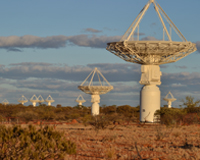ASKAP Timeline

ASKAP, CSIRO's new radio telescope, is located at Inyarrimanha Ilgari Bundara, the CSIRO Murchison Radio-astronomy Observatory in the Mid West region of Western Australia. The table below outlines the key stages of construction of the telescope and its supporting infrastructure.
| Activity | Date |
| Parkes Test-bed commissioned | June 2008 |
| Construction of all 36 ASKAP antennas complete | June 2012 |
Murchison Radio-astronomy Observatory (MRO) support infrastructure complete
|
July 2012 |
Start of system verification testing
|
August 2012 |
MRO Support Facility complete
|
February 2013 |
ASKAP BETA (Boolardy Engineering Test Array)
|
July 2013 |
ASKAP 12 PAF stage
|
March 2014 |
Continued PAF roll-out
|
mid-2014 |
ASKAP "Early Science" commences
|
October 2016 |
36th Mk II PAF installed
|
November 2017 |
RACS-I observing begins
|
April 2019 |
| Pilot Surveys Phase I observations begin | August 2019 |
| Pilot Surveys Phase II observations begin | July 2021 |
| Full Surveys commence with one-month trial | November 2022 |
Further Information
- Read the latest ASKAP Update newsletter
ASKAP
Access:
Public
